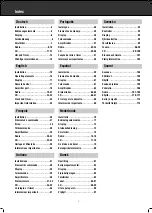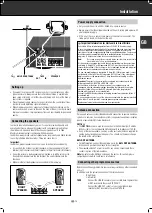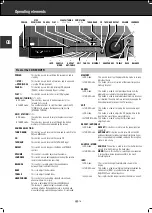
Switching on and off
When you want to switch your receiver on, press the
POWER
button. The red
LED in the middle of the button indicates that the unit is on.
button depressed: POWER ON
button not depressed: STANDBY
The receiver will be activated and the last selected source will be selected.
When the receiver is switched to active mode (as described below), the LED in
the power knob lights up.
The receiver is muted for approximately 3 seconds when it is turned on in order
to suppress disturbing initial signal noise.
To switch the receiver to stand-by press the
POWER
button again.
Stand By
You can switch the system to STAND BY with the
y
button on the remote
control or with the
POWER
button.
The display shows the clock time.
When you want to switch your system on again, simply press one of the input
selection buttons on the unit or on the remote control or the
POWER
button.
Source Selection
To select a listening source, press either the corresponding button on the unit
or the corresponding button on the remote control.
Automatic Source Selection
When the receiver is switched on, the receiver automatically switches to the CD
input as soon as you press the CD player
B
button.
Sound control
VOLUME
The volume can be adjusted with the rotary
VOLUME
knob.
The volume can also be controlled via the remote control
with the
/–
buttons.
MUTING
The volume can be completely muted by pressing the
ĭ
button on the remote control.
This is useful, for example, if you want to take a telephone
call and do not want to be distracted by music, news, etc.,
from your system.
If the muting function is used when recording a tape, this
has no effect on the subsequent recording volume level as
only the speakers are muted.
The click you hear when you press the
ĭ
button comes from
the relay which mutes the speakers.
The MUTING function can be deactivated by pressing the
ĭ
button again or by pressing the button on the
remote control or any one of the input selection buttons.
BASS, TREBLE
The
BASS
and
TREBLE
controllers can be used to
individually adjust the higher and lower frequencies from the
sound of your speakers. In this way, you can compensate for
surrounding acoustic irregularities which may be caused, for
example, by sound reflection behaviour on walls with
relatively large, empty surface areas, or ‘damping’ caused
by furniture or other objects.
LOUDNESS
Pressing the
LOUDNESS
button slightly accentuates the
lower and higher frequencies which renders a more balanced
overall sound during quieter passages.
Its effectiveness depends in turn on the setting of the volume
knob. The sound is thus optimally adapted to human hearing
sensitivity, which is also dependent on the respective
volume.
If you have connected speakers which exhibit a great deal of
bass,
LOUDNESS
should always remain off to achieve a
more linear acoustic pattern. In this way, you compensate for
excessive emphasis of the lower frequencies.
DEFEAT
The
DEFEAT
switch can be used to deactivate the bass and
treble control without changing the respective settings.
This function merely bypasses the signal path through the
bass and treble controls ensuring that the original sound is
reproduced with the highest fidelity.
BALANCE
For effective stereo playback, it is important that the sound
emanates equally from both speakers.
Acoustic equalibrium can be distorted by furniture groups or
the listener´s position in a room, thus distorting the
impression of stereo sound.
The
BALANCE
controller can compensate for such
distortions.
©
18
Amplifier part
GB

































